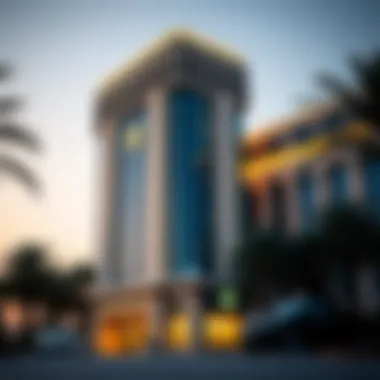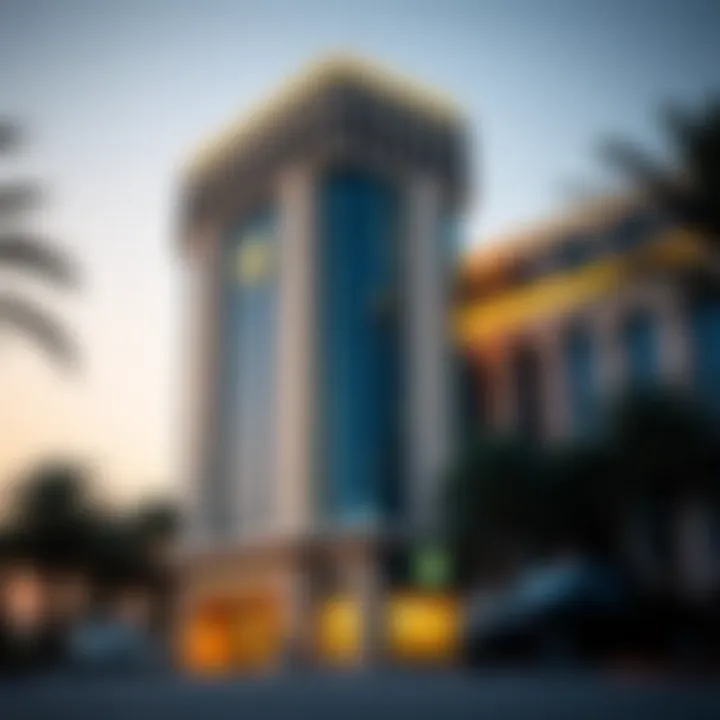Assessing the UAE's Status as the Safest Country


Intro
The conversation around safety often hinges on concrete statistics and personal experiences. When it comes to the United Arab Emirates, this topic takes on a life of its own, woven into the very fabric of the nation. Is the UAE genuinely the beacon of safety it claims to be, or is this perception merely a well-crafted facade? In an era where crime rates can fluctuate like the stock market, it's essential to dig deep beneath the surface and explore the various elements that contribute to a sense of security.
A combination of factors shapes the safety narrative in the UAE, from crime rates and governance to societal attitudes toward law enforcement. These elements present a multi-layered picture that is far more telling than simple statistics might suggest. For investors, real estate professionals, and potential residents, understanding the dynamics of safety is imperative not just for peace of mind but for making informed decisions.
Let's dissect the landscape to better understand the key aspects of safety within the UAE, starting with a look at the current market trends.
Market Trends
Current Property Prices
The UAE’s real estate market is akin to a roller coaster—exciting yet unpredictable. Across different emirates, property prices can shift from sky-high to surprisingly attainable based on various local factors, including demand, economic conditions, and, importantly, perceptions of safety. In cities like Dubai and Abu Dhabi, the average price per square meter can reflect both luxury and stability, often attracting global attention.
For instance, in Dubai, the average property price per square meter can hover around AED 13,000, while Abu Dhabi often sees lower averages, around AED 10,000. But these figures don't reveal the whole story. Properties in communities perceived as safer and more desirable often command a premium. As investors look for secure places to park their money, the neighborhoods with lower crime reports and a gang of amenities organically draw interest.
Future Market Projections
Looking down the line, the property market in the UAE is forecasted to experience significant growth driven not just by external investments but also by local developments aimed at enhancing safety and livability.
- Infrastructural Improvements: Investment in smart technology and security systems is on the rise. For instance, several new residential areas are integrating advanced surveillance tech to up their safety game.
- Gated Communities: The rise of gated communities reflects a natural human inclination towards safety. There's a growing trend toward these developments, which typically offer controlled access and community-oriented environments.
- Government Initiatives: The UAE government has rolled out various policies aimed at boosting economic stability – including increasing safety measures. These initiatives are expected to positively impact real estate prices.
With these trends in mind, it's not just a question of whether the UAE is the safest country but also how that safety translates into appealing market conditions for potential homebuyers and investors.
Lifestyle Insights
Neighborhood Highlights
In the UAE, neighborhoods can feel worlds apart. Areas like Palm Jumeirah in Dubai tout opulent living with a sense of security that comes from high-end security features and a community of affluent residents. In contrast, the heart of Abu Dhabi offers the Corniche, a vibrant promenade that balances safety with a rich cultural experience.
The choices are varied, and understanding the neighborhood dynamics helps guide decisions.
Community Amenities
Beyond just living space, the UAE invests heavily in community amenities that enhance both safety and overall quality of life. Community centers, parks, and recreational spaces serve as hubs for social interaction, fostering a sense of community. In various neighborhoods, amenities include:
- 24/7 Security Services: Ensuring peace of mind for all residents.
- Smart Surveillance Systems: Integrated technology enhances safety while providing comfort.
- Accessible Public Spaces: Parks and community centers that encourage activity and neighborly engagement often create bonds that enhance feelings of safety.
Prelude to the Safety Debate
In an ever-globalizing world, the concern for safety transcends borders and cultures. The United Arab Emirates has emerged as a focal point of safety-related discourse, especially given its rapid development, diverse population, and unique socio-political landscape. As we explore the question of whether the UAE qualifies as the safest country in the world, it is crucial to consider multiple dimensions of safety.
Understanding safety isn't just about counting crime statistics or reading headlines; it involves a nuanced look at social stability, emergency services, community engagement, and cultural attitudes towards law enforcement. Safety metrics are not set in stone; they evolve as socio-economic conditions shift. In this article, we will unpack these layers to offer a comprehensive perspective.
Key considerations include:
- Crime Rate Metrics: How do the numbers compare to global averages?
- Social Cohesion: How do community relationships influence the notion of safety?
- Government Initiatives: What policies does the UAE implement to maintain a safe environment?
- Global Comparisons: With the UAE often benchmarked against nations like Singapore and Japan, how does it stack up?
For investors, residents, and potential homeowners, gauging safety carries weight beyond mere statistics. The perceived safety of a region can heavily influence property values, market interest, and long-term investment sustainability. Thus, examining safety in the UAE is not just an academic exercise; it has real-world implications for various stakeholders.
As we proceed, we’ll delve into the criteria and context that frame this safety discussion. It is our goal to highlight critical aspects that make the UAE an interesting case study in global safety, backed by research, insight, and comparative analysis.
Understanding Safety Metrics
Understanding safety metrics is not just a casual affair; it plays a pivotal role when assessing whether a region can stake claim to being the safest country in the world. Metrics give tangible form to abstract concepts of safety, translating them into quantifiable data that can be analyzed and interpreted. This section delves into the various facets of safety metrics, highlighting their significance in gauging the safety landscape of nations, especially the UAE.
Safety does not exist in a vacuum. It is influenced by a myriad of elements—crime rates, government policies, community involvement, and even the socio-economic makeup of the population. When we think of safety metrics, it's crucial to consider not just the numbers, but the context behind them. For instance, a high crime rate on paper could be offset by swift law enforcement response or community outreach programs.
The metrics provide multiple benefits:
- They create a benchmark to judge safety across different nations and regions.
- They allow potential residents or investors to make informed decisions.
- They foster a sense of transparency and accountability in government policies regarding crime and public safety.
In this article, we aim to address the multifaceted nature of these metrics. By digging into various methods of evaluating safety, we aspire to paint a clearer picture of where the UAE stands in relation to global safety standards.
Defining Safety in Global Context
When talking about safety, one cannot overlook that it is a relative term. Safety can mean different things depending on cultural, social, and economic contexts. In a global landscape, it encompasses not just crime rates but also health security, political stability, and even environmental safety. In many developed countries, debates over public safety often revolve around gun laws, whereas, in others, issues like access to clean drinking water or healthcare may dominate discussions.
For the UAE, a modern and rapidly developing nation, safety is often equated with law enforcement efficiency, cultural tolerance, and vibrant economic opportunities. Each of these aspects contributes to the overarching concept of safety as perceived both locally and internationally.
Evaluative Criteria for Safety Rankings
Safety rankings are constructed using various evaluative criteria, each with its strengths and weaknesses. Here are some key parameters often analyzed:
- Crime Rates: These are perhaps the most visible indicators of safety. The rates of violent crimes, property crimes, and white-collar offenses are commonly scrutinized.
- Police Presence: The efficacy of law enforcement agencies, including response times and community engagement, significantly sways safety perceptions. Higher police visibility often equates to increased feelings of safety among residents.
- Judicial Efficiency: A well-functioning justice system contributes to public confidence in safety. If residents feel that crimes are prosecuted fairly and swiftly, they are likely to experience a higher sense of security.
- Social Cohesion: Societies with a strong sense of community and mutual support commonly see lower crime rates. Thus, demographics and social structures can influence safety metrics as well.
- Public Health Indicators: Recent global discussions have highlighted the importance of health in safety. Countries with robust healthcare systems can mitigate the impact of health crises, contributing to overall safety.
"Safety is not just the absence of crime but the presence of opportunities for growth and wellbeing."
In summary, understanding safety metrics involves poking around beyond face-value statistics. It requires looking deeper into the societal fabric that supports or undermines safety. The UAE, with its unique blend of tradition and modernity, presents a compelling case study in the realm of safety consciousness.
The insights garnered from this section will serve as a foundation as we transition into a closer examination of crime statistics and the socio-political influences at play in determining safety within the UAE.
Crime Statistics in the UAE
Understanding crime statistics in the UAE is crucial to framing the discussion around safety and security in the region. It provides a clear picture of the current environment, and how perceived risk relates to the realities on the ground. For investors and potential residents, grasping these statistics can offer insights into the safety of living or working in the country.
Moreover, these statistics can influence real estate desirability, as people often lean towards areas that showcase minimal crime.


Overview of Crime Rates
When examining crime rates in the UAE, it is vital to consider not just numbers but context. Overall, many reports indicate that crime rates in the UAE are relatively low compared to global standards. Organizations like the UAE's Ministry of Interior often publish reports which provide detailed assessments.
For instance, violent crime remains rare, and petty crime like pickpocketing is not prevalent in busy areas. An effective police force and strict laws play pivotal roles in maintaining this order. High surveillance in public spaces also serves as a deterrent against crime, lending credibility to safety claims.
Types of Crimes Commonly Reported
Theft and Robbery
Theft and robbery, while reported, do not dominate the crime landscape in the UAE. The strict penalties for these offenses often discourage criminals. Data shows that incidents involving theft tend to occur more in tourist-heavy zones, where the likelihood of unattended belongings is higher.
A key characteristic of theft in this context is its relatively low impact on community safety compared to other regions. This makes it a useful point of analysis, particularly for investors looking to tap into markets where security is prioritized. For instance, malls and marketplaces employ robust security, overshadowing concerns regarding theft incidents. However, it’s worth noting that the perception of theft can still affect community satisfaction.
Violent Crimes
When discussing violent crimes, one must highlight that they are quite rare in the UAE. Cases involving violence tend to be centered around personal disputes rather than random acts against the public. This consistency in low rates of violent crime bolsters the UAE's image as a safe haven.
A notable advantage of examining violent crime statistics is understanding the efficacy of local law enforcement. Their proactive approach in crime prevention contributes significantly to maintaining peace in the country. Yet, despite their rarity, violent crimes can still bring attention to potential areas of caution for residents and expats.
Cybercrime
Cybercrime is an evolving area of concern as technology penetrates daily life. In the UAE, as in other parts of the world, this type of crime is on the rise due to increasing internet penetration and a tech-savvy population. As more businesses and individuals rely on digital transactions, threats such as hacking, identity theft, and online fraud become more apparent.
Despite being a growing concern, the UAE has initiated several preventive measures that show their commitment towards combating cybercrime. Government agencies regularly conduct awareness campaigns. This proactive stance is essential not only in protecting citizens but also contributes positively to the nation’s business appeal. A well-informed public is less vulnerable to these threats, ultimately enhancing the overall safety perception in the region.
In summary, crime statistics tell a nuanced story of safety in the UAE. Low violent crime rates, controlled theft incidents, and evolving strategies against cyber threats reflect the complex layers of security. Understanding this landscape informs better decision-making for investors and residents alike.
Comparative Analysis with Global Safety Standards
In the quest to determine if the UAE stands as the safest country globally, a comparative analysis with other nations becomes indispensable. This scrutiny reveals nuances not only in crime statistics, but also in the effectiveness of law enforcement, community engagement, and cultural perceptions of safety. Such comparisons allow us to see where the UAE excels and where it might lag behind, providing a holistic view that goes beyond mere numbers.
UAE vs. Global Averages
When pitted against global averages, the UAE often showcases impressive metrics in safety indices. For instance, crime rates in urban centers like Dubai and Abu Dhabi tend to fall well below those of many major cities globally. The UAE has consistently recorded low rates of violent crime. In fact, The World Population Review indicates that the UAE has one of the lowest murder rates worldwide, positioning the nation favorably on the global safety scale.
"In 2022, the UAE recorded a murder rate of approximately 1.11 per 100,000 inhabitants, a stark contrast to the global average of around 6.1."
Moreover, the country's stringent laws, alongside a robust judicial system, reinforce this perception of safety. Surveys conducted by various platforms show that residents typically feel safer walking the streets alone, even at night. This sentiment is substantial when you contrast it with countries experiencing higher crime rates, where such feelings may not be as prevalent.
Yet, it’s essential to acknowledge the limitations of these comparisons. The methodologies of collecting and interpreting crime statistics vary globally. Some countries might underreport crimes due to cultural factors or flaws in data collection processes. Thus, while the UAE appears commendably safe on paper, one should consider the context behind these figures.
Key Comparators: Singapore and Japan
To frame the UAE’s safety characteristics more thoroughly, it’s valuable to juxtapose it against paragons of safety like Singapore and Japan. Both countries are renowned for their low crime rates and high levels of public safety, making them appropriate benchmarks for evaluation.
Singapore is a compelling case. Its crime rates are astoundingly low, often attributed to strict laws and a well-trained police force. Both the UAE and Singapore have made headlines for their rigorous law enforcement methods, yet Singapore’s integrated community-based policing measures offer lessons in citizen participation that might benefit the UAE.
On the other hand, Japan also exhibits exceptional safety rates accompanied by distinctly different cultural norms. The Japanese tend to emphasize community-based prevention strategies and a deep-rooted sense of social responsibility. Unlike the top-down approach often seen in the UAE, Japan’s focus on community engagement in safety initiatives fosters a unique environment of trust between citizens and law enforcement.
Both countries possess stark discipline in law enforcement and social norms that discourage criminal behavior. Thus, the UAE can look towards these nations not just as competitors, but also as mentors in cultivating an even safer environment for its residents.
As we scrutinize these benchmarks, it becomes apparent that while the UAE boasts admirable safety metrics, there’s ample room for growth through cultural engagement, communal involvement, and continuous improvement of its law enforcement practices. This comparative analysis serves not merely as a measurement but as a catalyst for ongoing dialogue and development in safety standards throughout the region.
Key Takeaways
- The UAE generally has low crime rates, particularly in violent offenses.
- Global comparisons illuminate both strengths and weaknesses in the UAE's safety metrics.
- Learning from countries like Singapore and Japan can aid the UAE in achieving even higher safety standards.
For further reading:
Continual analysis helps in understanding how safety evolves globally, and how nations like the UAE can utilize such insights to maintain its status. The essence lies in fostering not only a safe environment but also a proactive community that feels empowered and engaged.
Socio-Political Influences on Safety
To understand safety in the United Arab Emirates, one must examine the socio-political landscape that underpins it. The UAE has established itself as a beacon of security in a chaotic region, but its safety is not merely a stroke of luck. The nexus of government policies, law enforcement, and cultural attitudes towards crime create a unique environment that significantly influences the overall safety perception.
Government Policies and Law Enforcement
The government of the UAE takes a pragmatic approach to safety that revolves around stringent law enforcement and well-structured policies. The Ministry of Interior plays a pivotal role in maintaining public order and ensuring a secure environment. The laws here are not just regulations; they are the backbone of a peaceful societal framework.
- Strict Penal Code: The UAE has a stringent legal system that encompasses severe penalties for various crimes. This act as a deterrent against potential offenders, fostering a communal spirit of respect for the law.
- Proactive Policing: Law enforcement agencies, including the Police of Dubai and Abu Dhabi, actively engage in community policing strategies that enhance relations between the police and residents. The intent is to create trust, making it easier to report crimes and suspicious activities without fear of retribution.
- Investment in Technology: There's a considerable investment in modern technology, such as surveillance and smart city initiatives, which facilitate faster response times and enhance public safety. This blend of traditional policing and modern tech creates a robust safety framework that's hard to override.
The combination of these components creates a sense of security that resonates deeply within the community. As a result, residents and tourists alike often express sentiments reflecting the high level of comfort they experience while in the UAE.
Cultural Attitudes Towards Crime and Safety
Cultural norms play a monumental role in defining safety in the UAE. The population, which includes a melting pot of various cultures, embodies a unique blend of traditions that favor social harmony and respect for the law.
- Community Responsibility: In many Emirati neighborhoods, there is a prevailing attitude where residents feel a sense of responsibility towards each other's safety. It's not uncommon for neighbors to look out for one another, fostering a protective environment. This cultural trait adds an additional layer of safety that goes beyond law enforcement.
- Low Tolerance for Misconduct: The societal norm here does not tolerate misconduct. This collective mindset discourages crime, as engaging in criminal activities is socially frowned upon. Residents tend to respect the state's authority and the laws that govern their lives.
- Educational Initiatives: The UAE government invests in educational programs that promote safety and awareness among its inhabitants. Whether it’s academic institutions or community workshops, these initiatives inform people about the importance of reporting crimes and understanding their rights.
"Safety is not just about crime rates; it's about the interplay of laws, culture, and community spirit that fosters a secure environment."
For further insights into safety perceptions, consider visiting Britannica, or read public safety documents from the UAE Government.
Understanding these influences provides a comprehensive perspective that underscores the UAE's reputation as one of the safest places globally.
Community Engagement and Safety


Community engagement profoundly influences the safety landscape within the UAE. Increasingly, safety does not solely reside in law enforcement or political policies, but also in how residents and local groups interact with each other and their environment. Understanding this relationship sheds light on the UAE's standing in the international safety spectrum.
It’s important to realize that local communities act as the first line of defense against crime. When residents take ownership of their neighborhoods, the feeling of camaraderie discourages criminal activities and enhances the overall safety vibe.
Role of Local Communities in Enhancing Safety
Local communities have a pivotal role in creating and sustaining a safe environment. In the UAE, where multiculturalism weaves through daily life, it's essential for different communities to establish bonds.
- Neighborhood Watch Initiatives: In various emirates, locals have come together through neighborhood watch programs. These initiatives not only keep an eye on suspicious activities but also foster a sense of connectivity among residents.
- Cultural Events: Numerous community cultural events aim to bridge gaps between different nationalities. By creating opportunities for interaction, they foster a sense of unity. For instance, annual festivals might include discussions about safety protocols alongside cultural performances.
Moreover, community engagement goes beyond mere participation. Active involvement in safety programs empowers individuals to contribute solutions tailored to their specific needs. This might involve advocating for better lighting in public spaces or organizing safety workshops.
Programs and Initiatives for Safety
Several programs are underway to involve local communities in enhancing their own safety. These initiatives resonate with the overarching goal of making the UAE a safer place for all residents.
- Community Policing: Numerous emirates have adopted community policing models, which encourages local law enforcement to engage with communities. Officers attend local meetings and events to discuss safety, addressing resident concerns directly.
- Safety Services Facilities: Initiatives like the "Smart Police Stations" offer 24/7 services, allowing residents to report crimes or seek assistance without traditional barriers. This modern approach aligns perfectly with the UAE's technological advancements.
- Educational Workshops on Crime Prevention: Various groups regularly conduct sessions to educate residents on how to avoid scams or recognize suspicious behaviors. These workshops empower people with knowledge, transforming them from passive bystanders into proactive community members.
"Safety is not just the absence of crime; it's a collaborative effort that thrives on mutual trust and proactive engagement between the community and its members."
Personal Safety Considerations for Residents
When pondering the question of safety in the UAE, it's essential to consider how individuals, particularly residents, perceive and engage with their environment. Personal safety is not just a metric; it's a lived experience that intertwines with everyday life. Residents, from local citizens to expatriates, often have specific needs that influence their feelings of security. These needs can include everything from crime prevention and rapid emergency response to community support and engaging local governance.
Residents tend to navigate their safety attitudes based on various elements such as their immediate environments, societal attitudes, and personal experiences. It's crucial to have a nuanced understanding of how these aspects interplay, considering cultural backgrounds, varying levels of integration within the community, and ever-changing urban dynamics.
Safety for Expats: Challenges and Solutions
For expatriates in the UAE, safety can sometimes feel like walking a tightrope. While the general crime rate is low, challenges do exist. Language barriers, unfamiliarity with local laws, and cultural differences can amplify feelings of vulnerability. Many expats find themselves in a state of anxiety when it comes to understanding housing regulations, employment rights, and local customs. However, there are also abundant resources to help mitigate these concerns, such as community groups and expatriate services.
Expat residents benefit significantly from proactive safety measures like local seminars on personal rights and local laws, which many community organizations offer. Furthermore, governments often launch campaigns directed at creating awareness about safety measures that cater specifically to the needs of foreign residents.
Neighborhood Safety: What to Know
The neighborhoods within the UAE range from bustling urban centers to quieter suburban areas, and each offers unique safety characteristics.
Market Areas
Market areas in the UAE, such as the Souk Al Bahar in Dubai and the Abu Dhabi Central Market, are vibrant places full of life. They are often bustling with traders and shoppers alike, creating a lively atmosphere. However, while the lively scene can be charming, it also poses some safety concerns such as pickpocketing, particularly in crowded conditions.
The key characteristic of these market areas is their accessibility and the variety of goods and services offered. A beneficial aspect for residents and visitors is the presence of security personnel who actively engage with the public, providing a sense of safety. Nonetheless, the sheer volume of tourists can create overwhelming situations, making it crucial for locals and expats to remain aware and alert.
Residential Communities
Residential communities, like Emirates Living or Al Reem Island, play a critical role in determining personal safety. These places generally feature gated entries, security staff, and surveillance systems that contribute to a secure living environment. A noteworthy characteristic is the sense of community that fosters communication among residents. This social connectivity often leads to a shared vigilance regarding safety issues.
The unique advantage of residing in such communities lies in the established networks of trust and support. Still, it's essential to research and choose communities with a proven safety record, as not all are created equal.
Tourist Spots
Tourist spots, such as the Burj Khalifa and the Louvre Abu Dhabi, have robust safety measures in place to protect visitors. These sites typically have visible security checkpoints and management teams dedicated to ensuring a safe experience for everyone. The key characteristic here is the high foot traffic, coupled with increased security presence.
These areas are advantageous because they are well-monitored, yet the excitement can lead to situations where personal items may be at risk. Tourists and residents alike must navigate these settings with caution and awareness, ensuring they remain vigilant despite the bustling atmosphere.
Understanding these elements, including market areas, residential settings, and tourist attractions, is vital for anyone considering living in the UAE. As always, awareness and preparation serve as the first line of defense in ensuring personal safety.
Analysis of Emergency Services
Examining the emergency services aspect is crucial when assessing safety in the UAE. The efficacy of these services can either bolster the perception of safety or cast doubts on it. High-quality emergency services reflect not only a nation's commitment to public welfare but also the efficiency and readiness to handle crises. In the UAE, the emergency framework encompasses police, fire departments, and medical services, all of which play a pivotal role in maintaining safety and security.
Effectiveness of Emergency Response
In the UAE, emergency response times are impressive, thanks in part to state-of-the-art technological integration and streamlined processes. For instance, the Dubai Police has pioneered initiatives like the "smart police station," enabling quicker dispatch and coordination. The average response time for emergencies can often be just a few minutes. This rapid response can greatly reduce the severity of incidents, whether they are health-related emergencies, accidents, or criminal activities. Citizens’ trust in these services is a foundational component of the overall sentiment around safety.
The level of training received by emergency responders also merits attention. Continuous training programs ensure that personnel are well-equipped to handle various scenarios, from natural disasters to urban crimes. The investment in advanced training and equipment by the government serves to enhance not just operational efficiency but also public confidence. It signals a strong commitment to safety.
Public Awareness and Accessibility
Public awareness regarding emergency services is just as significant as their effectiveness. In the UAE, various campaigns and information dissemination efforts aim to educate residents about the available emergency services and the correct measures to take during crises. The government actively promotes knowledge of emergency contacts and procedures through educational programs in schools and community centers. This level of awareness creates an informed populace that can react adequately in emergencies, ultimately leading to better outcomes.
Accessibility of these services is another critical area. The UAE has made strides to ensure emergency services are available to all segments of society, including expatriates. Multilingual services reflect the diverse demographic landscape, ensuring that language barriers do not impede timely aid. Mobile applications have also been developed to facilitate easy access to emergency help, allowing users to reach out quickly and navigate the necessary channels.
Ensuring that these services remain accessible and well-known enhances the general perception of safety. A population that feels confident in their ability to obtain help when needed is likely to view their environment more favorably.
Timely access to emergency services can make the difference between life and death, underlining the importance of these systems in the overall safety landscape of a nation.
In sum, the emergency services in the UAE demonstrate a blend of technology, public education, and reliable operations that bolster the country's reputation as a safe place. For investors, realtors, and potential residents, understanding this aspect further delineates the narrative around safety in the UAE.
Relevant resources for further exploration of the UAE's emergency services include:
Investing in real estate or relocating to the UAE requires confidence not only in safety statistics but also in the emergency services that underpin these metrics.
Perceptions of Safety Among Residents
Understanding how residents perceive safety in the UAE is crucial when discussing its status as a safe country. This perception can significantly influence everything from community cohesion to property values, making it an essential topic for potential investors, homeowners, and anyone considering moving to the region. When we talk about safety perception, it’s not just about statistics; it's about how people feel in their daily lives.
Residents’ perceptions can shape neighborhoods, draw in new businesses, and even affect the local economy. If folks feel safe, they’re more likely to leave their doors unlocked or to take evening strolls, which can contribute to a vibrant community atmosphere. On the flip side, if there’s a pervasive anxiety regarding safety, that can lead to closed-off neighborhoods and lower property values.


It's also important to consider how various factors, such as cultural background or personal experiences, come into play when evaluating safety. For instance, a newcomer from a conflict-ridden area might view the UAE differently from a lifelong resident. These perceptions can vary widely and can influence how both the private and public sectors respond to safety issues.
Moreover, when organizations invest in safety initiatives, they often do so partly to influence perceptions positively. By addressing safety concerns, they hope to attract not just residents but also investors drawn by lower risks and a stable environment. Thus, understanding these perceptions wraps back to the central theme—how safe is the UAE really?
Survey Results and Public Opinion
Surveys and polls conducted among residents highlight the general consensus toward the perception of safety in the UAE. A recent survey indicated that over 85% of residents feel safe walking alone at night, which contrasts sharply with statistics from cities around the world. This perception is rooted in several aspects of living in the UAE:
- Low crime rates: As discussed in previous sections, relatively low crime rates directly enhance residents' confidence.
- Effective law enforcement: The visible presence of police and security personnel reassures residents.
- Community initiatives: Programs encouraging neighborly bonds foster a culture of vigilance and support, ensuring that residents feel secure.
However, not all survey findings are overwhelmingly positive. Some respondents expressed concerns about cyber threats and personal safety concerning bank transactions, highlighting an area where perception does not match reality. This divergence can lead to calls for more localized safety campaigns that address specific fears rather than relying solely on overarching statistics.
"It’s about how you feel on the ground, not just what numbers say. Statistics can be as slippery as a greased pig when it comes to tackling real fears,” said one resident.
Factors Influencing Perception of Safety
Various factors impact how residents in the UAE view their safety. Among these, several key influences stand out:
- Cultural Background: Residents from differing countries bring their own experiences and expectations regarding safety. For instance, someone from a country with high crime rates may feel safer in the UAE compared to someone from a low-crime environment.
- Media Influence: The portrayal of safety issues in local and international media can profoundly influence perceptions. Coverage of a crime, for instance, could lead to heightened fears among the community, regardless of actual crime trends.
- Personal Experiences: Individual stories and firsthand experiences shape perceptions immensely. If a resident has faced a crime or a safety issue, this can skew their view of safety in the UAE.
- Community Response: How communities react to crime can influence perceptions. A proactive community that reports issues and engages with law enforcement can foster a more robust sense of security.
- Government Policies: Stringent laws and active prevention measures, such as strict penalties for criminals, can also bolster residents' feelings of safety.
Each of these factors can interconnect to paint a colorful, yet complex, picture of safety perception within the UAE. Understanding these elements is essential not just for residents but also for investors and developers looking to navigate the real estate landscape actively.
To wrap up, perceptions of safety are a nuanced matter, shaped by a blend of experiences, cultural nuances, and community dynamics. Getting a handle on this topic is indispensable for anyone looking to make informed decisions regarding their future in the UAE or invest in its burgeoning real estate market.
The Role of Technology in Enhancing Safety
In today’s rapidly evolving world, technology has cemented itself as a cornerstone in the quest for safety. Particularly in the UAE, where a unique blend of tradition and modernity thrives, the integration of technology into safety measures plays a pivotal role. This section explores how technology not only boosts security infrastructure but also fosters a societal culture where safety is paramount.
One key area where technology shines is in surveillance systems. With a diverse population and a booming economy, the UAE faces unique security challenges. Surveillance systems act as the watchful eyes, capturing real-time data and providing authorities with essential tools to prevent crime before it happens. The effectiveness of these systems is worth exploring, as the very fabric of urban safety hinges upon them.
Surveillance Systems and Their Effectiveness
Surveillance systems in the UAE are more than mere cameras placed on street corners. These systems incorporate advanced technologies, ranging from facial recognition software to drone surveillance. According to local law enforcement, cities like Dubai have invested heavily in high-resolution cameras that monitor public spaces 24/7.
- Facial Recognition Technology: Used in places such as airports and shopping malls, this tech can identify individuals and track their movements, enhancing public safety.
- Integrated Monitoring Solutions: Agencies collaborate to share data across platforms. This interconnectedness allows for quicker response to incidents and a more cohesive security approach.
"The technological prowess in surveillance has made the vast expanse of the UAE, especially urban areas, feel like a safe haven. People are comforted by the presence of these systems that are always on guard."
However, the reliance on technology does spark conversations surrounding privacy and civil liberties. Balancing security and individual rights is a delicate act. The approach taken by the UAE has been one of openness to innovation while maintaining a framework that respects personal freedoms.
Innovations in Emergency Communication
The strength of any safety protocol is put to the test during emergencies. The UAE has implemented several innovations in emergency communication, helping streamline responses and improve coordination between different agencies.
- Emergency Apps: With a population diverse in languages and cultures, mobile applications tailored for immediate alerts in multiple languages ensure that essential information reaches everyone. Through the app, residents can report emergencies or suspicious activities directly to the police.
- Social Media Monitoring: Government agencies actively monitor social channels like Twitter and Facebook. When crucial updates arise, these platforms become effective channels for disseminating information swiftly.
These advancements mean that not only is immediate help just a call away, but information flows seamlessly across platforms. In emergencies, the initial minutes significantly impact outcomes, and the UAE's technological investments in emergency communication serve to minimize response times and enhance safety.
The intersection of technology and safety in the UAE paints a powerful picture of modern governance. With thoughtful consideration of technology as a tool for enhancing security rather than an intrusion into daily life, the UAE continues to forge ahead, exhibiting that a harmonious blend of innovation and community vigilance is key to perceived safety.
Investing in Safety: Implications for Real Estate
The discussion surrounding safety plays a crucial role in the real estate market in the UAE. The perception of safety, backed by statistical evidence, directly influences investor confidence, property values, and the overall health of the housing market. Investors are not just seeking a mere roof over their heads; they desire a dwelling in a community where safety is paramount and maintained by effective governance. This interest is particularly evident in regions like Dubai and Abu Dhabi, where cosmopolitan living meets world-class amenities, bolstered by a solid security infrastructure.
Real estate developers recognize that by embedding safety features into their projects, they can attract buyers looking for peace of mind. Features may range from high-tech surveillance systems to strict neighborhood watch programs. Such enhancements do more than merely keep crime at bay; they uplift the entire community’s appeal. Imagine a neighborhood where residents not only feel secure but also take pride in maintaining a safe environment for their families and visitors. This collective responsibility fosters a strong sense of community.
Attracting Investors through Safety Metrics
In the realm of real estate, safety metrics are becoming a linchpin in attracting prospective buyers and investors. Property listings often highlight low crime rates, the presence of law enforcement, and community safety initiatives along with the appealing aesthetics of homes. This information caters to a burgeoning demand; recent surveys indicate that potential homeowners prioritize safety as one of the top considerations when selecting a neighborhood.
"Investors want to know that their investment is not just a financial one but also a safe haven for themselves and their families."
For instance, properties located near areas recognized for their rigorous safety measures can command premium prices. Highlighting features like neighborhood crime statistics, community policing effectiveness, and emergency response times can distinctly influence buying decisions. As additional metrics emerge, such as environmental safety and the impact of urban planning on crime reduction, these factors could further improve the investment landscape.
Housing Market Trends Related to Safety Perception
The relationship between safety perception and housing market trends is an intricate dance. When safety perceptions rise, so do property values. Conversely, negative incidents or perception shifts can lead to a decline in both average prices and demand. A notable example occurred in neighborhoods where increased crime reports surfaced, resulting in a marked fall in property sales and rental inquiries.
A few noteworthy trends include:
- Growth in Demand for Secure Properties: Many buyers are leaning toward gated communities or properties equipped with advanced security frameworks.
- Emergence of Competitive Pricing: Regions with high safety ratings often experience competitive pricing, as both buyers and renters are willing to pay more for peace of mind.
- Influence of Environmental Safety: As climate change and natural disasters become more prominent, properties with sustainable features are gaining traction, impacting their safety perception.
Culmination: Is the UAE the Safest Country?
In tackling the notion of whether the UAE stands out as the safest country in the world, it’s crucial to distill the vast array of factors influencing the debate. Distinct aspects such as crime rates, governmental structure, and community engagement play pivotal roles in shaping perceptions of safety. The word on the street and hard statistics often tell a contrasting story; while official reports show low crime rates, local sentiments about safety might diverge.
A central finding reflected in our exploration is that the UAE often ranks highly in safety indices, especially when compared with other global contenders. The consistency in low crime statistics can be attributed to stringent law enforcement, cultural respect for authority, and rigorous immigration protocols which, combined, foster a generally secure environment. However, one must not overlook that nominal safety can sometimes mask underlying tensions.
Moreover, the interaction between different cultures living side by side in the UAE offers a unique tapestry of experiences. Newcomers and long-term residents may have varied perceptions based on their backgrounds and personal encounters. Hence, it raises questions about what truly constitutes safety. Is it simply the absence of crime or the presence of community trust and open communication? Potential long-term residents and investors must weigh these elements carefully as they consider their next steps.
Summary of Findings
Upon surveying the myriad aspects of safety in the UAE, one can't help but notice the establishment's efforts to maintain peace and order. Significant takeaways include:
- Low Crime Rates: Official statistics paint a picture of a safe haven, particularly in urban centers like Dubai and Abu Dhabi, where violent crimes are notably scarce.
- Government Initiatives: The local administration actively implements policies aimed at boosting public safety, ranging from technology-driven surveillance systems to community policing efforts.
- Cultural Synergy: The UAE, being a melting pot of cultures, experiences differing perceptions regarding safety, influenced by individual backgrounds and local norms.
- Community Initiatives: Local organizations and neighborhood councils play a vital role in fostering a sense of safety, often organizing events and discussions that bring residents together.
These elements underscore that while statistics can provide a clear picture of crime rates, they do not fully encapsulate the lived experiences of individuals within these urban spaces.
Future Considerations for Safety in the UAE
Looking ahead, the narrative around safety in the UAE will likely evolve alongside the broader socio-economic landscape. A few key considerations include:
- Technological Advancements: With rapid developments in technology, including artificial intelligence and surveillance systems, the future could see even more innovative approaches to maintain safety and order. The integration of smart technology in urban planning might enhance responsiveness to emergencies.
- Community Policing: As community engagement grows, strategies for effective safety measures may increasingly leverage local insights and participation, raising awareness on safety issues that matter most to residents.
- Cultural Tensions: Continuous influx of expats may lead to shifts in cultural dynamics. Understanding and managing these aspects will be key to preserving the safety that many currently enjoy.
- Economic Impacts: Changes in global economic conditions may influence levels of tourism and expat residents in the UAE, indirectly impacting crime rates and perceptions of safety.
Ultimately, while the UAE enjoys a reputation as a safe place, it is essential to keep an open dialogue about safety considerations. The balance between the impressive statistics and the nuanced realities will dictate how the future unfolds. Those looking to invest, reside, or visit would do well to stay informed about these evolving aspects.











